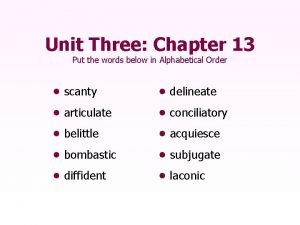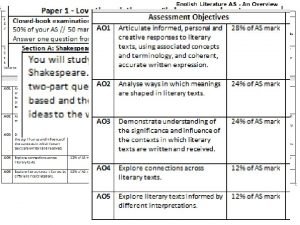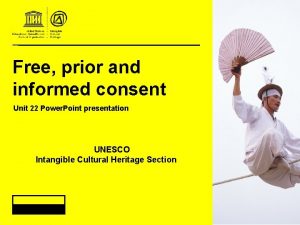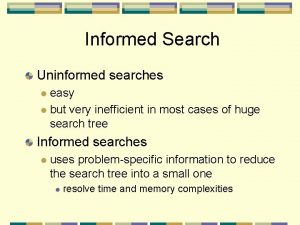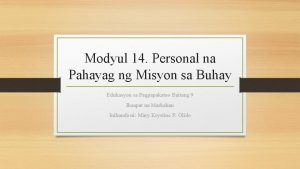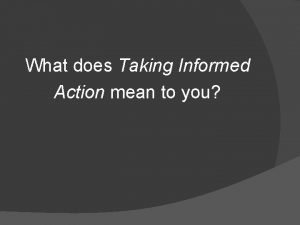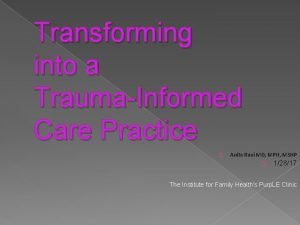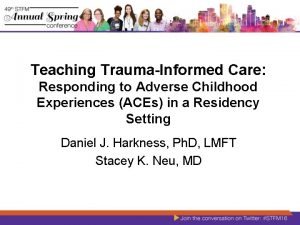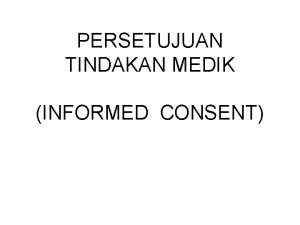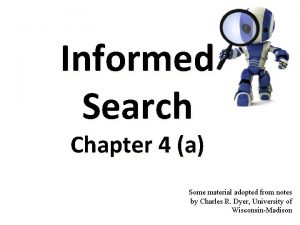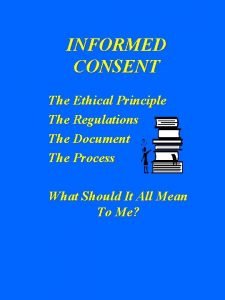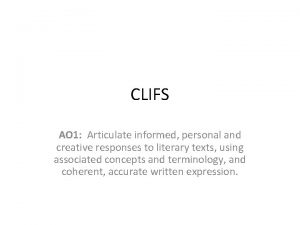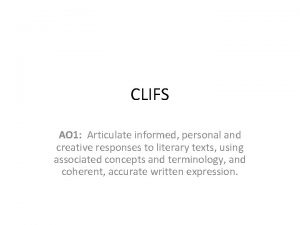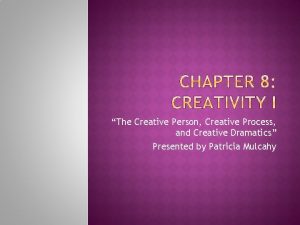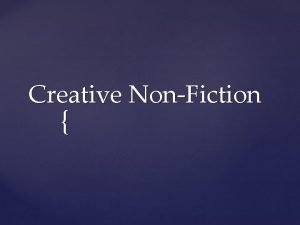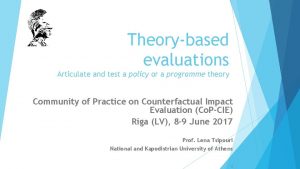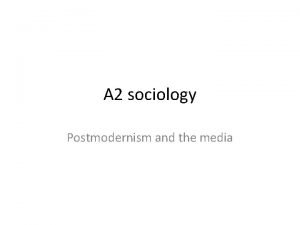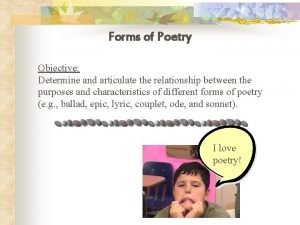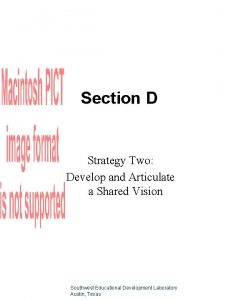AO 1 articulate informed informed personal and creative









![Otranto was so popular it made the Gothic novel [or the Gothic romance] the Otranto was so popular it made the Gothic novel [or the Gothic romance] the](https://slidetodoc.com/presentation_image_h2/64539707e67f27d11df06fca18cd1cac/image-10.jpg)





























- Slides: 39

AO 1 – articulate informed, informed personal and creative responses to literary texts, using associated concepts and terminology AO 2 – Analyse ways in which meanings are shaped in literary texts AO 3 – Demonstrate understanding of the significance and influence of the contexts in which literary texts are written and received AO 4 – Explore connections across literary texts. AO 5 – Explore literary texts informed by different interpretations Gothic Literature The Nightmare (1781), by Henry Fuseli -inspired the scene of Elizabeth’s murder in Frankenstein.

Look at the painting on your handout. Make brief notes on what you see, e. g: -which part attracts your attention most and why you think this is - three or four adjectives describing the emotions it might cause in a viewer - any questions it raises - connections to films, novels, poems or other paintings

Mysterious, eerie image – unsettling for the viewer A creature with some human features but also strange, supernatural, ‘other’ Horrible, ugly and threatening creature Gloom and darkness = sense of threat Oppositions – human/not human; living/dead; male/female; awake/asleep An image that raises questions: a horrible dream? A real life ‘nightmare’? Woman in sexual pose? Or dead? Awake or asleep? White versus dark – purity and innocence versus threat

What do you understand by the term ‘gothic’?

Look at the images, quotations from literary texts and quotes from literary criticism you have been given. What sort of themes, plots and characteristics do you think feature in Gothic literature? Create a mind map.

Definitions Gothic Novel: “Tales of the macabre, fantastic, and supernatural, supernatural usually set amid haunted castles, graveyards, ruins, and wild picturesque landscapes. ” “The word “Gothic” originally implied “medieval, ” but in the later 18 th cent. its meaning altered until its emphasis lay on the macabre, and the original medieval element was sometimes wholly forgotten. ” Gothic Revival: A revival of the Gothic style of architecture which began in the late 18 th cent. with a new romantic interest in the medieval […], followed in the 19 th cent. by a more scholarly study of Gothic [poetry & prose]. -From The Oxford Companion to English Literature, Fifth Edition

The Gothic Genre In Literature the word ‘Gothic’ refers to fiction dealing with the supernatural or terrifying events. The term also refers to a kind of atmosphere linked to spirits. The Gothic genre was popular in England in the late 18 th century and the first two decades of the 19 th century.

Gothic architecture th th 12 ~16 century Gothic architecture used pointed arches and vaults, flying buttresses, narrow spires, stained glass windows, intricate traceries, and varied details; its upward movement was meant to suggest heavenward aspiration.

The History of Gothicism §In the 1740 s the writer Horace Walpole bought Strawberry Hill, an estate on the Thames near London, which was remodelled with turrets to look “Gothick. ” §This sparked off a fashion for Gothic housing which spread across England can still be seen today. §Its popularity peaked in the 1790 s and early 19 th century. §In 1764, Walpole produced the first “true” Gothic novel: The Castle of Otranto: A Gothic Story. Otranto’s Gothic elements: -Supernatural happenings: -Haunted castle -Moaning ancestral portrait -Mysterious deaths -A male villain: -Egotistical -Tyrannical -Maniacal -A fair damsel in distress -“Terror, anguish and love. ”
![Otranto was so popular it made the Gothic novel or the Gothic romance the Otranto was so popular it made the Gothic novel [or the Gothic romance] the](https://slidetodoc.com/presentation_image_h2/64539707e67f27d11df06fca18cd1cac/image-10.jpg)
Otranto was so popular it made the Gothic novel [or the Gothic romance] the most common type of fiction for half a century. The first edition claimed to be a translation of a twohundred-year-old Italian manuscript (the ‘medieval translation’ is a motif that continues to be well used in Gothic and wider literature). It was only in 1765, with the publication of the second edition that Walpole decided to attach his own name to it.

Gothicism and the Romantics §For British Romantics, literary Gothicism was a type of “imitation medievalism. ” § In the late 18 th cent. it connoted terrifying experiences in ancient castles [subterranean dungeons, secret passageways, flickering lamps, screams, bloody hands, ghosts, graveyards and etc. ] §By extension, it came to designate the macabre, mysterious, fantastic, and supernatural. Samuel Taylor Coleridge, Romantic poet, author of the Rime of the Ancient Mariner

Early Gothic classics -Vathek, by William Beckford (1786) -by Ann Radcliffe: -The Romance of the Forest (1791) -The Mysteries of Udolpho (1794) -The Italian (1797) -The Monk, by Matthew Gregory Lewis -by C. R. Maturin: Shared Gothic elements: -Medieval settings -Blends terror, cruelty and eroticism -In The Monk and Mrs. Radcliffe’s works: -Seduction -Incest/Rape -Matricide/Murder (1796) -Diabolism -The Fatal Revenge (1807) -Melmoth the Wanderer (1820) §Jane Austen’s Northanger Abbey (1818) and Thomas Love Peacock’s Nightmare Abbey (also of 1818) both mock the established form of Gothic romance, and in particular Mrs. Radcliffe’s popular work The Mysteries of Udolpho.

Those that followed… §Many Victorian writers were influenced by Gothic literature. §Renowned examples are: -The work of the Brontë sisters [eg: the scene in Charlotte Brontë’s Jane Eyre where the old chestnut tree is struck in half by lightening] -That of Charles Dickens [eg: all the events, imagery and symbolism of Miss Havisham in Great Expectations]. § Some American writers influenced by Gothic literature are Charlotte Perkins Gilman [The Yellow Wallpaper] Wallpaper and Edgar Allen Poe [The Raven, The Pit and the Pendulum, William Wilson, and many morbid more]. §Modern “Gothic” works: Note: Women writers did -Mervyn Peake’s Titus Groan (1946) fantastically in this period: and Gormenghast (1950) -The Bloody Chamber by Angela Carter Best-selling author: Ann - The Wasp Factory by Iain Banks Radcliffe, “Queen of Terror” - The Woman in Black by Susan Hill Most enduring novel: Mary - Beloved by Toni Morrison Shelley’s Frankenstein - The Turn of the Screw by Henry James Most effective parody: Jane §And poetry: Browing, Plath, Coleridge, Poe… Austen’s Northanger Abbey

Ann Radcliffe (9 July 1764 – 7 February 1823) Very little is known of her life. "She never appeared in public, nor mingled in private society, but kept herself apart, like the sweet bird that sings its solitary notes, shrouded and unseen. ” (Edinburgh Review) • married to a journalist who worked long hours • she wrote to occupy herself whilst he was away • the money she earned from her books allowed them to travel (along with their dog) • when she died, some claimed she was insane • her husband claimed she died of an asthma attack

Radcliffe made the Gothic novel socially acceptable. Her success attracted many imitators, mostly of low quality, which soon led to a general perception of the genre as inferior, formulaic, and stereotypical (The Romance of the Forest is a favourite of the rather dull Harriet Smith in Jane Austen’s Emma) but she herself was well regarded. Radcliffe did not like where Gothic literature was headed, and her final novel, The Italian, was written in response to Matthew Gregory Lewis' The Monk. It is assumed that this frustration is what caused Radcliffe to cease writing. After Radcliffe's death, her husband released her unfinished essay "On the Supernatural in Poetry, " which details the difference between the sensation of terror her works aimed to achieve and the horror Lewis sought to evoke.

Basic Plot Structure for a Gothic Novel • Action in the Gothic novel tends to take place at night, or at least in a claustrophobic, sunless environment. • ascent (up a mountain high staircase); • descent (into a dungeon, cave, underground chambers or labyrinth) or falling off a precipice; secret passage; hidden doors; • the pursued maiden and the threat or rape or abduction; • physical decay, skulls, cemeteries, and other images of death; ghosts; revenge; family curse; blood and gore; torture; the Doppelganger (evil twin or double); demonic possession; masking/shape-changing; black magic; madness; incest and other broken sexual taboos.

How does the synopsis of The Romance of the Forest match up to the basic plot structure of a Gothic novel? Using the outline from the previous slide and the comments by reviewers and critics (from early 18 th and late 20 th century) on your handout (‘The Gothic Genre’), highlight the connections where you find them.

Synopsis from Amazon: Set in a Roman Catholic Europe of violent passions and extreme oppression, the novel heroine follows the fate of its Adeline, who is mysteriously placed under the protection of a family fleeing Paris for debt. They take refuge in a ruined abbey in south-eastern France, where sinister relics of the past - a skeleton, a manuscript, and a rusty dagger - are discovered in concealed rooms. Adeline finds herself at the mercy of the abbey's proprietor, a libidinous Marquis whose attentions finally force her to contemplate escape to distant regions. Rich in allusions to aesthetic theory and to travel literature, The Romance of the Forest is also concerned with current philosophical debate and examines systems of thought central to the intellectual life of late eighteenth-century Europe.

Gothic Conventions …and The Romance of the Forest

Setting “The setting of the Gothic Novel is a character in itself. ”

The plot is usually set in a castle, an abbey, a monastery, or some other (usually religious) building, which has secrets of its own. It is this gloomy and frightening scenery, which sets the scene for what the audience should expect. The setting is greatly influential in Gothic novels. It not only evokes the atmosphere of terror and dread, but also portrays the deterioration of its world. The decaying, ruined scenery implies that at one time there was a thriving world. At one time the abbey, castle, or landscape was something treasured and appreciated. Now, all that lasts is the decaying shell of a once thriving dwelling.

The major part of the action in The Romance of the Forest is set in an abandoned and ruined abbey. The building is a mirror for the action in the novel, and its tunnels serve as a hiding place for the characters and as a place of secrets. The main characters live in constant fear of discovery by either the police or Adeline’s father and, at times, certain characters believe the abbey to be haunted. It is sublime. On the other hand, the abbey also serves as a comfort, as it provides shelter and safety to the characters. It is beautiful. Finally, it is picturesque, in that it was a ruin and serves as a combination of the both the natural and the human. Edmund Burke’s theory of the sublime and the beautiful The sublime: a source of awe or fear brought about by strong emotions such as terror or mental pain The beautiful: those things bringing pleasure and safety Burke argued that the sublime was the more preferred of the two The picturesque: a combination of the sublime and the beautiful, e. g. a natural or uncultivated beauty, such as a beautiful ruin or a partially overgrown building

From ‘Romance of the Forest’ He entered what appeared to have been the chapel of the abbey, where the hymn of devotion had once been raised, and the tear of penitence had once been shed; sounds, which now could be recalled only by imagination--tears of penitence, which had long since been fixed in fate. La Motte paused a moment, for he felt a sensation of sublimity rising into terror--a suspension of mingled astonishment and awe! He surveyed the vastness of the place, and as he contemplated its ruins, fancy bore him back to past ages. "And these walls, " said he, "where once superstition lurked, and austerity anticipated an earthly purgatory, now tremble over the mortal remains of the beings who reared them!"

Metonymy of gloom and terror Metonymy is a subtype of metaphor, in which something e. g. “the pen is mightier than the sword” “the pen” = “the written word” “the sword” = “military aggression and force” (like rain) is used to stand for something else (like sorrow). For example, the film industry likes to use metonymy as a quick shorthand, so we often notice that it is raining in funeral scenes.

Note the following metonymies that suggest mystery, danger, or the supernatural wind, especially howling sighs, moans, howls, eerie sounds rain, especially blowing clanking chains doors grating on rusty hinges gusts of wind blowing out lights footsteps approaching doors suddenly slamming shut lights in abandoned rooms crazed laughter characters trapped in a room baying of distant dogs (or wolves? ) thunder and lightning ruins of buildings

Weather is used in a number of ways and forms, some of these being: Mist - This convention in Gothic Literature is often used to obscure objects (this can be related to the sublime) by reducing visibility or to prelude the insertion of a terrifying person or thing; Storms - These frequently accompany important events. Flashes of lightning accompany revelation; thunder and downpours prefigure the appearance of a character or the beginning of a significant event; Sunlight - represents goodness and pleasure; it also has the power to bestow these upon characters.

“Emily gazed with melancholy awe upon the castle, which she understood to be Montoni's; for, though it was now lighted up by the setting sun, the gothic greatness of its features, and its mouldering walls of dark grey stone, rendered it a gloomy and sublime object. As she gazed, the light died away on its walls, leaving a melancholy purple tint, which spread deeper and deeper, as the thin vapour crept up the mountain, while the battlements above were still tipped with splendour. From those too, the rays soon faded, and the whole edifice was invested with the solemn duskiness of evening. Silent, lonely and sublime, it seemed to stand the sovereign of the scene, and to frown defiance on all who dared to invade its solitary reign. As the twilight deepened, its features became more awful in obscurity, and Emily continued to gaze, till its clustering towers were alone seen, rising over the tops of the woods, beneath whose thick shade the carriages soon after began to ascend. ” - The Mysteries of Udolpho Look at this extract from another one of Radcliffe’s novels. How is it a ‘typical’ Gothic setting?

Archetypal Characters “The Gothic hero becomes a sort of archetype as we find that there is a pattern to his characterization. There is always the protagonist, usually isolated either voluntarily or involuntarily. Then there is the villain, who is the epitome of evil, either by his (usually a man) own fall from grace, or by some implicit malevolence. The wanderer, found in many Gothic tales, is the epitome of isolation as he wanders the earth in perpetual exile, usually a form of divine punishment. ” – David De Vore

Virginal Maiden – young, beautiful, pure, innocent, kind, virtuous. Shows these virtues by fainting and crying whenever her delicate sensibilities are challenged, usually starts out with a mysterious past and it is later revealed that she is the daughter of an aristocratic or noble family. Adeline in The Romance of the Forest – “a beautiful girl, who appeared to be about eighteen. Her features were bathed in tears and she seemed to suffer the utmost distress. ” She is a virtuous character whose piety and unflinching optimism cause all to fall in love with her. Older, Foolish Woman - Madame La. Motte in The Romance of the Forest – naively assumes that her husband is having an affair with Adeline. Instead of addressing the situation directly, she foolishly lets her ignorance turn into pettiness and mistreatment of Adeline.

The Villain – burdened by a terrible secret or sorrow; proud; strong but sensitive; striking physical presence; strong sexual element; driven by an all-consuming passion; a connection with the exotic, non-human or bestial. Sometimes also the In The Romance of the Forest hero! This would later develop into the Byronic hero, or anti-hero (e. g. Heathcliff in Wuthering Heights) • The Hero (to rescue the heroine and marry her!) • The Tyrant (sometimes also the villain; threatens to rape or kill the heroine) • The Stupid Servant (comic relief; a device to move the story onwards; a messenger) • Bandits/ Ruffians (to threaten or kidnap the heroine) • Clergy (always weak, usually evil) Theodore saves Adeline multiple times, is virtuous and brave and self-sacrificial The Marquis attempts to rape and murder Adeline Peter brings information but prattles on rather than get to the point Bandits kidnap Adeline flees a convent where sisters are not allowed to see sunlight – a highly oppressive environment

Other Gothic Conventions • Secret corridors, passageways, or rooms • Ruined castles with graveyards nearby • Priests and monks • Sleep, dream, death-like states • The double or ‘doppelganger’ • Forbidden power or knowledge • Madness/questioning one’s own sanity • Ancestral curses/ cursed or blessed objects/ holy relics • Ambiguity and ambivalence • A sense of mystery or dread • The threat of murder and/ or incest • An exploration of the darkness of humankind • The supernatural • Revenge • The outsider • The distressed heroine • The pursued protagonist • Marriage as a resolution • Strong moral closure

Look at the extract from The Romance of the Forest on your handout. Can you pick out any features that you think are characteristic of the Gothic genre? Look for: • Characters • Setting • Use of metonymy • Conventions You could also look for lexical clusters (e. g. groups of words to do with darkness) or consider the style of the extract, e. g. the sentence lengths, structures and punctuation.

In pairs, look at your extract from a core Gothic text. Pick out 3 -4 features that you think are characteristic of the Gothic. You might look for: • Typical characters or settings • Lexical clusters (e. g. words to do with darkness) • Style (e. g. is there anything distinct about sentence length or punctuation? )

Beyond Feature Spotting If you choose Gothic for your coursework topic, you will need to be able to explore what the features you identify are doing in the text. Many Gothic texts explore the same underlying concepts. Some of these are on your handout. One possible topic is the female Gothic. “The role of women in the Gothic genre is as victims, always subject to male authority. ” Compare and contrast the extent to which this interpretation is relevant to your chosen texts.

Supernatural Explained With the development of the Female Gothic came the literary technique explaining the supernatural of. The ‘Supernatural Explained’is a recurring plot device in The Romance of the Forest. It sets up suspense for horrific events, which all have natural explanations. Radcliffe’s use of Supernatural Explained is characteristic of the Gothic author. The female protagonists pursued in these texts are often caught in an unfamiliar and terror terrifying landscape, delivering higher degrees of. The end result, however, is the explained supernatural, rather than terrors familiar to women, such as rape, incest, ghosts or haunted castles. The replacement of true supernatural horrors with explained cause and effect transforms romantic plots and Gothic tales into common life and writing. These are not mere fables, but have some real-life resonance with the lives of the women who read them. Read the extract from The Romance of the Forest on your sheet. How does this fit with the features of the Gothic genre?

Watch the video of David Punter talking about the female Gothic and read the extracts on your handout. What do you think of his argument? From what you know of Adeline, and comparing her to characters from other Gothic texts you may be familiar with, what sort of role do you think women play in Gothic literature? Examples: Frankenstein – in this novel are women innocent victims who die (through illness, as the victim of revenge)? Wuthering Heights – a housekeeper; a ghost-child; an innocent daughter; a passionate and wilful woman. How would you describe the different roles played by the women in this novel? Dracula – how is Gothic used to explore fears about the ‘new woman’? How do some of the female characters adopt conventionally male characteristics and roles?

Independent Study. An essay exploring connections and comparisons between two related texts. A maximum of 2500 word, plus bibliography. • Your choice • Must include at least one pre-1900 text • Linked by period or genre You can choose your texts and title, but we have given you a reading list and some suggestions to help.

"Secret meaning is not a hidden layer but a hidden organisation of the surface". In light of this view, compare and contrast the presentation of the hidden or secret in your chosen texts. "The Gothic imagination turns upon a fear of objects, in particular the individual's anxiety of becoming subject to forces beyond its control”. In light of this view, compare and contrast the ways the Gothic settings of your chosen texts help the writers to shape their presentation of heroines in peril. “Terror awakens the faculties to a high degree of life; horror contracts, freezes and nearly annihilates them. " How far do you find this a pertinent comment when comparing and contrasting the presentation of the sublime in your chosen texts? “The role of women in the gothic genre is as victims, always subject to male authority. ” Compare and contrast the extent to which this interpretation is relevant to the presentation of women in your chosen texts.

informed AO 1: Articulate , personal and creative responses to literary texts, using associated concepts and terminology AO 2: Analyse ways in which meanings are shaped in literary texts AO 3: Demonstrate understanding of the significance contexts in which literary and influence of the texts are written and received AO 4: Explore texts. connections across literary AO 5: Explore literary texts informed by different interpretations
 Articulating your value download
Articulating your value download Articulate vocabulary
Articulate vocabulary Chapter 13 ten words in context acquiesce
Chapter 13 ten words in context acquiesce Dr george giuliani
Dr george giuliani What is an informed personal response
What is an informed personal response Free prior and informed consent
Free prior and informed consent Informed and uninformed search in artificial intelligence
Informed and uninformed search in artificial intelligence Difference between informed and uninformed search
Difference between informed and uninformed search Uninformed and informed search
Uninformed and informed search Vervo personal
Vervo personal Adivinanzas de higiene
Adivinanzas de higiene Itala ang mga pansariling pagtataya sa kasalukuyang buhay
Itala ang mga pansariling pagtataya sa kasalukuyang buhay Taking informed action examples
Taking informed action examples 4 r's trauma informed care
4 r's trauma informed care Lgbtq trauma informed care
Lgbtq trauma informed care Dr anita ravi
Dr anita ravi Pillars of trauma informed care
Pillars of trauma informed care Keep satisfied manage closely monitor keep informed
Keep satisfied manage closely monitor keep informed Solace american pie
Solace american pie Power-interest grid
Power-interest grid Trauma-informed care activities for staff
Trauma-informed care activities for staff Informed (heuristic) search strategies
Informed (heuristic) search strategies Trauma-informed workplace assessment
Trauma-informed workplace assessment An informed guess or assumption about a certain problem
An informed guess or assumption about a certain problem You should seek to be an informed user of it because
You should seek to be an informed user of it because Trauma-informed questions for clients
Trauma-informed questions for clients 4 r's trauma informed care
4 r's trauma informed care Trauma informed legal advocacy
Trauma informed legal advocacy Kobtion
Kobtion Libby bergman
Libby bergman Statistics informed decisions using data 5th edition pdf
Statistics informed decisions using data 5th edition pdf Tina champagne
Tina champagne Psychologically informed environments
Psychologically informed environments Psychologically informed environments
Psychologically informed environments Undang undang persetujuan tindakan kedokteran
Undang undang persetujuan tindakan kedokteran Informed search example
Informed search example Best first search in ai
Best first search in ai Http informed delivery usps
Http informed delivery usps Informed delivery campaign
Informed delivery campaign Ethical principles governing informed consent process
Ethical principles governing informed consent process


